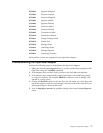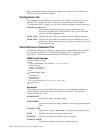
$AGENT_ADDR
Specifies the address of the object generating the trap.
$VARBIND Specifies a list of all non-fixed attributes.
$VB_NUM_VARS
Specifies the number of elements in $VARBIND.
$ADAPTER_HOST
The name of the host machine where the adapter runs.
Built-in Variables for $VARBIND: $VARBIND is a list of all non-fixed attributes.
To access the individual elements of $VARBIND, use the VB_# variables, where #
is a number greater than zero (0). For example, if $VARBIND has three elements,
you can use VB_1, VB_2, and VB_3 as variables to access the data. The following
example performs string functions on the elements of $VARBIND:
ATTR(=, "VB_1"), VALUE(CONTAINS, "some string")
Because $VARBIND is a list of strings, if it contains more than one element,
performing a string function like CONTAINS against $VARBIND causes the
adapter to end unexpectedly.
Object Identifier File
The object identifier file maps object identifiers used by SNMP to names. No
changes are necessary before the adapter is run.
Each line of this file has the following form:
"name""object identifier"
For example
"sysUpTime" "1.3.6.1.2.1.1.3"
"ifIndex" "1.3.6.1.2.1.2.2.1.1"
"whyReload" "1.3.6.1.4.1.9.2.1.2"
Note: Object identifiers must appear in increasing order.
You can use the names that are mapped to object identifiers in the CDS file.
Error File
The error file allows you to configure debugging and tracing options. The error file
is described in detail in “Error File” on page 19.
Starting and Stopping the Adapter
By default, the adapter is always started when the host starts up. You can also cold
start or warm start an adapter manually. A cold start causes the adapter to get new
bindings, read its adapter files, and restart the daemons. A warm start causes the
server only to re-read its adapter files.
Unless explicitly defined in the configuration file, the adapter searches for the CDS,
error, and object identifier files in the same directory as the configuration file.
Chapter 7. SNMP Adapter 85


















